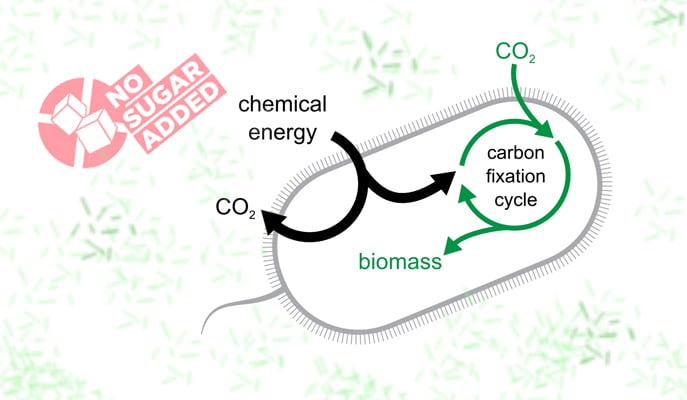
The term ‘e-coli bacteria’ is often associated with poor food hygiene and nasty diseases. The pathogenic bacterial strain is undoubtedly responsible for the latter. On the bright side, these bacteria are also useful residents in our intestinal flora. They are responsible for ensuring that we have enough vitamins in our bodies. They feed on sugar that we eat in our diet.
The bacteria in Prof. Ron Milo’s laboratory at the Weizmann Institute of Science in Rehovot (Israel), are a very special variety. They feed on carbon dioxide (CO2) and can produce biomass from air. The Finnish start-up Solar Foods Ltd also makes use of a similar principle which IO reported on this summer. They turn bacteria turn CO2 into food there. They do need light as a source of energy for this process. The genetically modified and rapidly evolving bacteria from Milo’s laboratory are in fact able to do their work in the dark.
Kicking the sugar habit
As a first step, the bacteria were given a gene that plants use to absorb carbon from CO2. This converts carbon into organic molecules such as protein, DNA and so on. In addition, scientists introduced a gene into the bacteria which gave them the ability to produce energy from a substance called ‘formate‘. This substance is made from electricity and air and is suitable for passing on electrons to the bacteria.
Next, they slowly let the bacteria detox from their usual sugar diet. These cultivated bacteria were given just enough sugar so as not to starve, along with a generous amount of CO2 and formate. Some of them learned to use CO2 more and more as a food. This gave them an evolutionary advantage over their sugar-dependent counterparts. Their offspring received less and less sugar in their diet. The strain adapted to the new food after about a year. They could live and multiply in an environment where only CO2 was available.

Scientists wrote in the scientific journal Cell that the bacteria were fed the heavy isotope C13 in order to test that they weren’t secretly ‘snacking’ on other nutrients. The scientists then weighed the bacteria and compared it with the mass of the heavier version of carbon so that they could check the weight that had increased. It turned out that the carbon atoms in the bacteria had actually all originated from the CO2 directly.
Climate-neutral energy
The researchers have identified what changes the microorganisms need to undergo in order to adapt their diet. They found that in some cases, the cause of the genetic adaptations in bacteria might have been related to the simple fact that they were just hungry. Other genetic changes had to do with how the bacteria collected CO2 and made organic building blocks from it. According to the researchers, the cells must “strike a balance between toxic excesses and collapse.” The way in which genes are switched on and off was another adaption that the scientists noticed. Nevertheless, there is still a lot of research to be done into how these genes are able to adapt their behaviour.
The scientists think that this new “health kick” by the bacteria might be beneficial to our planet if these microorganisms could be made to feed on CO2 and renewable energy instead of their current diet of corn syrup. They can also be modified so that they don’t get their energy from a substance such as formate, but directly from electrons instead. From a solar collector, for instance. This energy could then be stored as fuel in the form of carbon for later use. If this carbon were to come from the atmosphere, then this form of fuel would be completely CO2-neutral.
More articles on alternative fuels can be found here.

